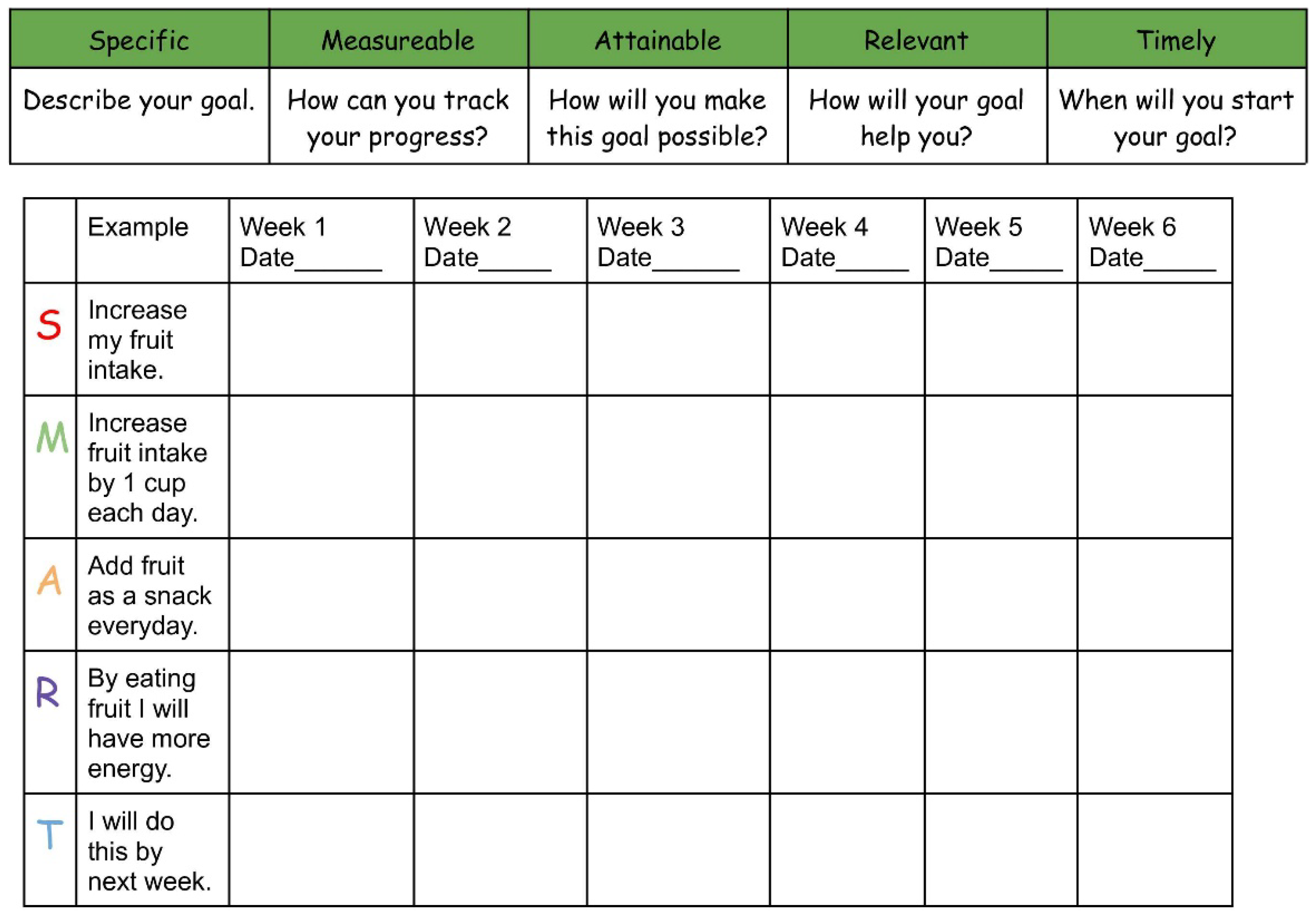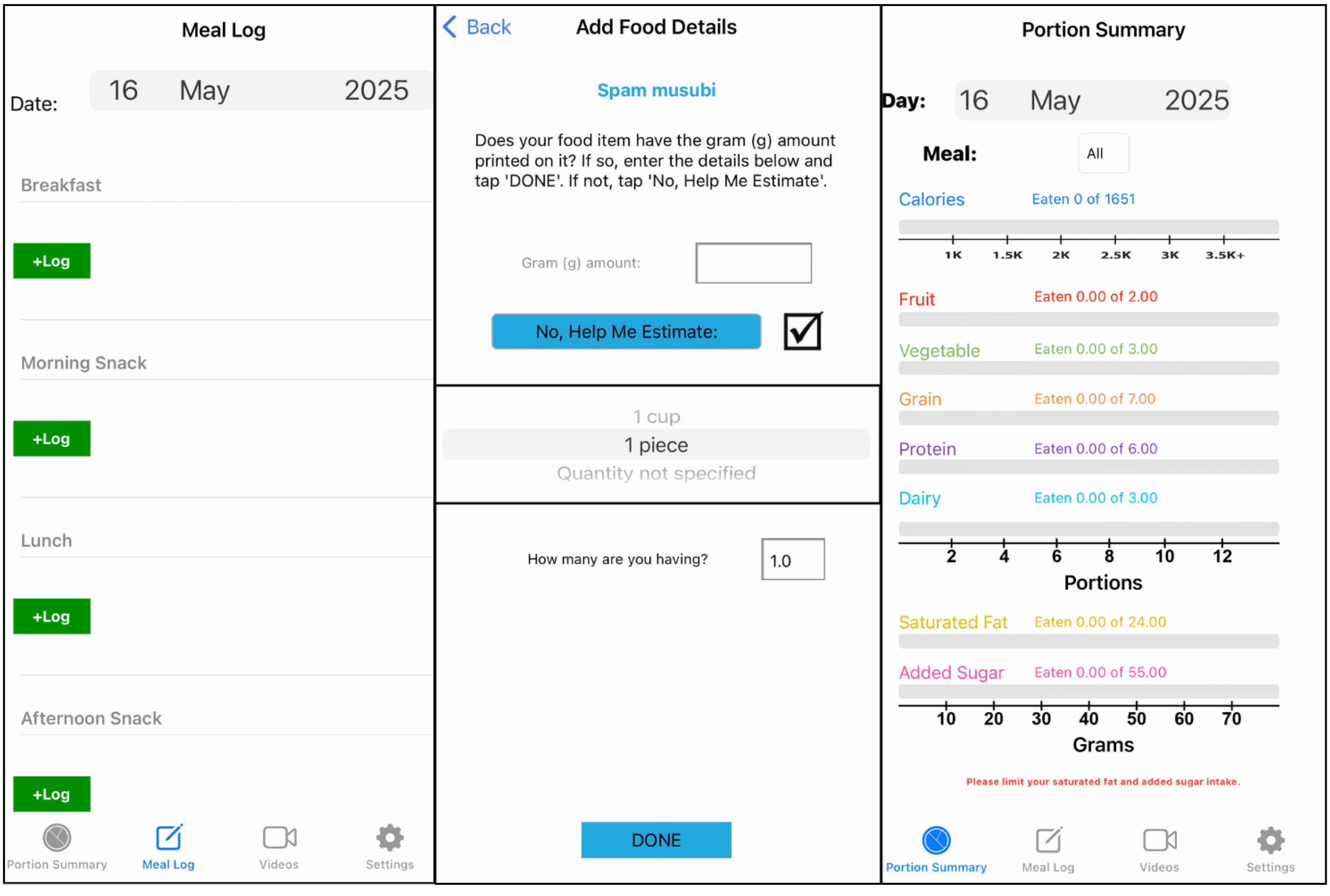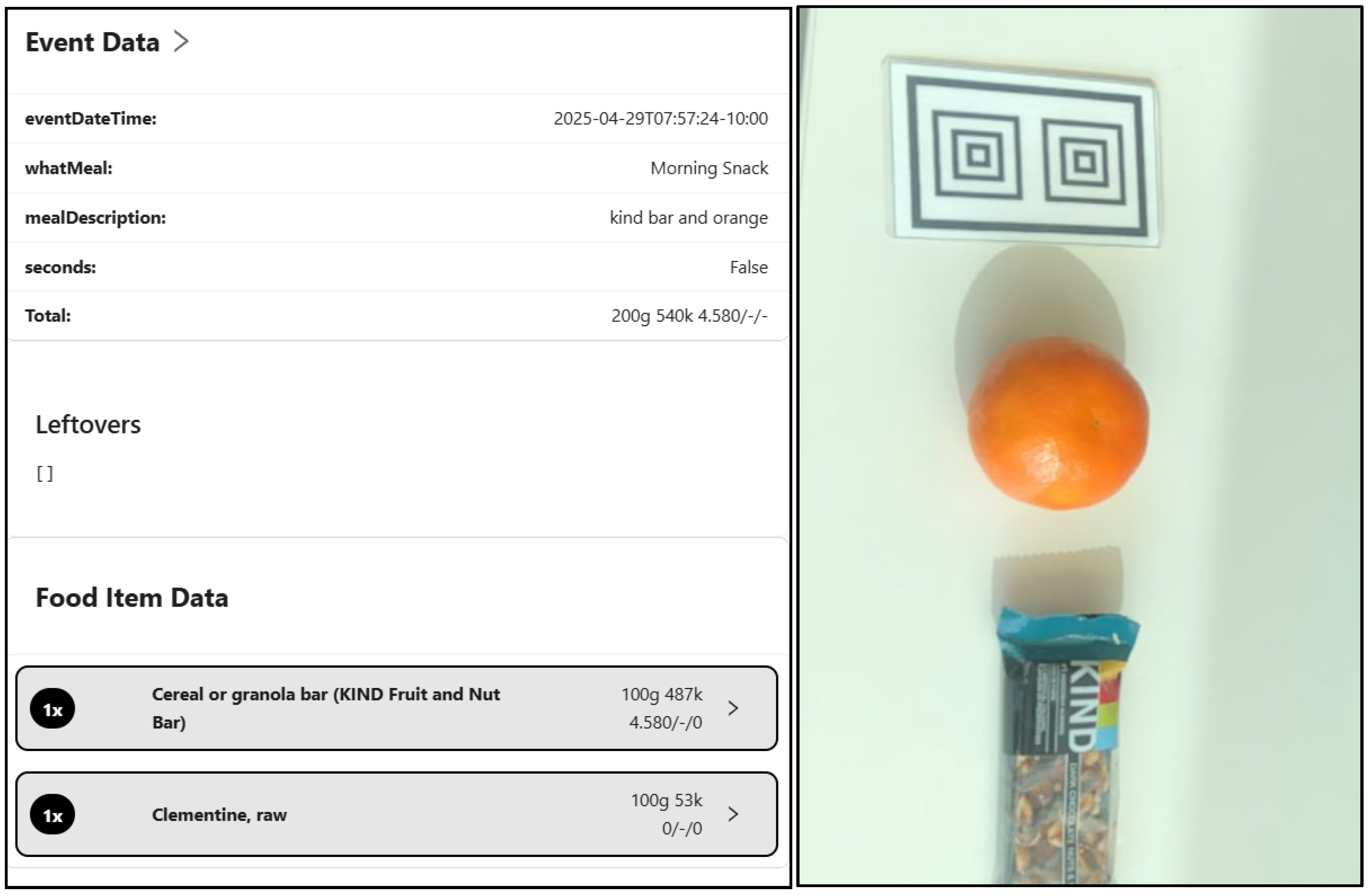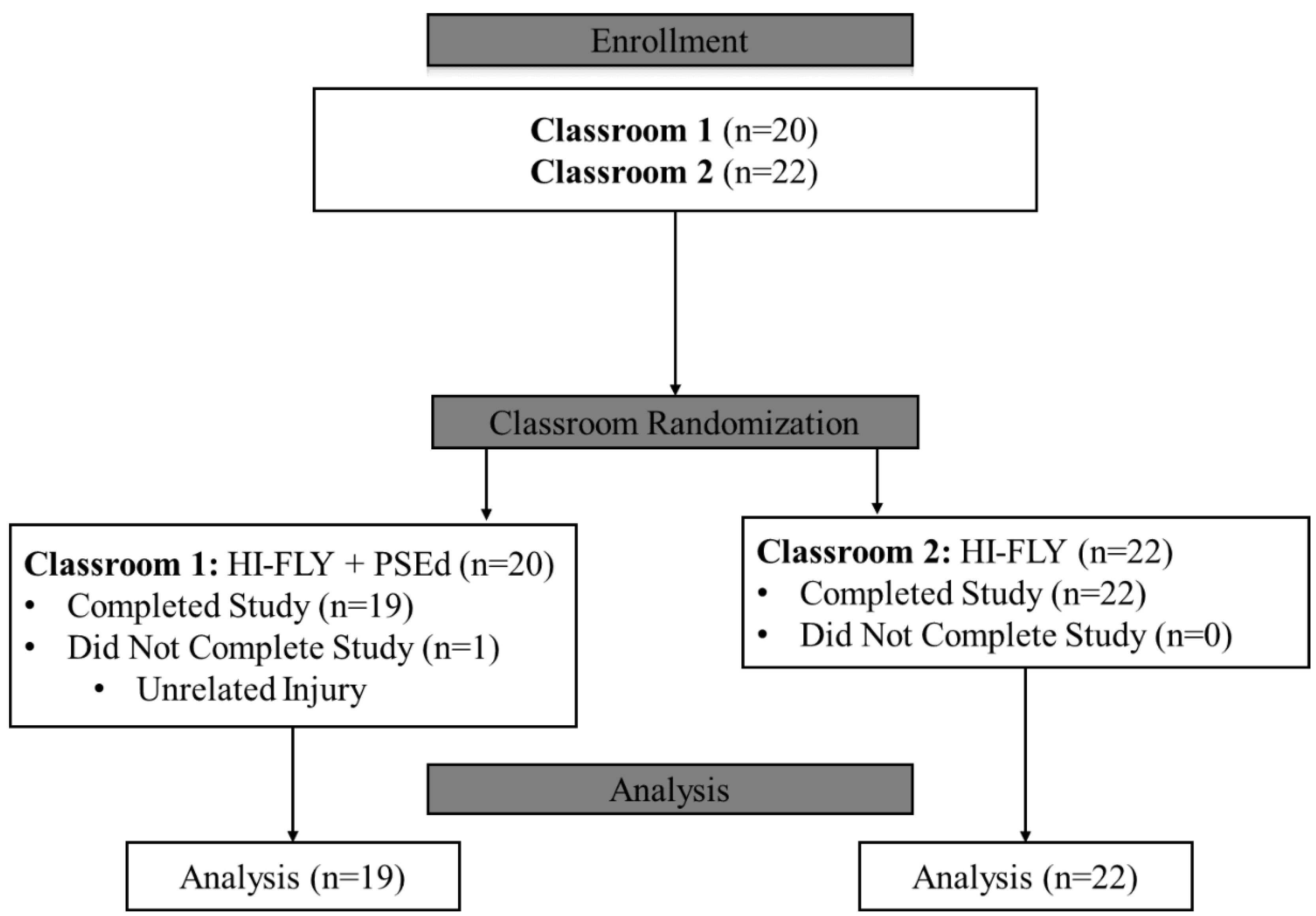Integration of the PortionSize Ed App into SNAP-Ed for Improving Diet Quality Among Adolescents in Hawaii: A Randomized Pilot Study
Abstract
1. Introduction
2. Materials and Methods
2.1. Ethical Approval
2.2. Study Design
2.3. Recruitment and Randomization
2.4. Measures
2.5. HI-FLY
2.5.1. Study Group Overview
2.5.2. Youth Questionnaire
2.5.3. HI-FLY Group Dietary Assessment
2.6. HI-FLY + PSEd
2.6.1. Study Group Overview
2.6.2. PSEd App
2.6.3. HI-FLY + PSEd Group Dietary Assessment
2.7. User Satisfaction Survey
2.8. Statistical Analysis
3. Results
3.1. Participant Flow
3.2. Participant Characteristics
3.3. User Satisfaction Survey
3.4. Dietary Analyses
3.4.1. Healthy Eating Index-2020
3.4.2. Youth Questionnaire
4. Discussion
Strengths and Limitations
5. Conclusions
Supplementary Materials
Author Contributions
Funding
Institutional Review Board Statement
Informed Consent Statement
Data Availability Statement
Acknowledgments
Conflicts of Interest
Abbreviations
| BMI | Body Mass Index |
| DCAP | Data Capture and Analysis Platform |
| DGA | Dietary Guidelines for Americans |
| FNDDS | Food and Nutrient Database Dietary Studies |
| FPED | Food Patterns Equivalent Database |
| HEI-2020 | Healthy Eating Index-2020 |
| HI-FLY | Hawaii—Food and Lifeskills for Youth |
| mHealth | mobile Health |
| NHPI | Native Hawaiian and Pacific Islander |
| PAL | Physical Activity Level |
| PSEd | PortionSize Ed |
| RFPM | Remote Food Photography Method |
| SMART | Specific, Measurable, Attainable, Realistic, Timely |
| SNAP-Ed | Supplemental Nutrition Assistance Program Education |
| US | United States |
| YQ | Youth Questionnaire |
References
- Okunogbe, A.; Nugent, R.; Spencer, G.; Powis, J.; Ralston, J.; Wilding, J. Economic impacts of overweight and obesity: Current and future estimates for 161 countries. BMJ Glob. Health 2022, 7, e009773. [Google Scholar] [CrossRef] [PubMed]
- Data by Policy. State of Childhood Obesity. Available online: https://stateofchildhoodobesity.org/data-by-policy/ (accessed on 15 June 2025).
- Stierman, B.; Afful, J.; Carroll, M.D.; Chen, T.-C.; Davy, O.; Fink, S.; Fryar, C.D.; Gu, Q.; Hales, C.M.; Hughes, J.P.; et al. National Health and Nutrition Examination Survey 2017–March 2020 Prepandemic Data Files—Development of Files and Prevalence Estimates for Selected Health Outcomes. In National Health Statistics Reports; The National Center for Health Statistics: Hyattsville, MD, USA, 2021. [Google Scholar] [CrossRef]
- Wang, Y.; Xue, H.; Huang, Y.; Huang, L.; Zhang, D. A Systematic Review of Application and Effectiveness of mHealth Interven-tions for Obesity and Diabetes Treatment and Self-Management. Adv. Nutr. 2017, 8, 449–462. [Google Scholar] [CrossRef]
- Hawaii State Departments of Education and Health, Hawaii Health Data Warehouse. Hawaii School Health Survey: Youth Risk Behavior Survey. 2024. Available online: https://hhdw.org/report/indicator/summary/BMIAdultAnyCatAA.html (accessed on 15 June 2025).
- Long, C.R.; Narcisse, M.-R.; Selig, J.P.; Willis, D.E.; Gannon, M.; Rowland, B.; English, E.S.; McElfish, P.A. Prevalence and associations between food insecurity and overweight/obesity among native Hawaiian and Pacific Islander adolescents. Public Health Nutr. 2023, 26, 1338–1344. [Google Scholar] [CrossRef] [PubMed]
- Mau, M.K.; Wong, K.N.; Efird, J.; West, M.; Saito, E.P.; Maddock, J. Environmental Factors of Obesity in Communities with Native Hawaiians. Hawaii Med. J. 2008, 67, 233–236. [Google Scholar]
- Nigg, C.R.; Ul Anwar, M.M.; Braun, K.; Mercado, J.; Kainoa Fialkowski, M.; Ropeti Areta, A.A.; Belyeu-Camacho, T.; Bersamin, A.; Guerrero, R.L.; Castro, R.; et al. A Review of Promising Multicomponent Environmental Child Obesity Prevention Intervention Strategies by the Children’s Healthy Living Program. J. Environ. Health 2016, 79, 18–26. [Google Scholar]
- Adeyemo, M.A.; Trinh, J.; Perez, D.; Bozeman, E.; Ntekume, E.; Gardner, J.; Thames, G.; Luong, T.; Carson, S.L.; Vassar, S.; et al. Community-Engaged Approaches for Improving the Inclusion of Diverse Communities in a Nutrition Clinical Trial. Nutrients 2024, 16, 3592. [Google Scholar] [CrossRef]
- Gurnani, M.; Birken, C.; Hamilton, J. Childhood Obesity: Causes, Consequences, and Management. Pediatr. Clin. N. Am. 2015, 62, 821–840. [Google Scholar] [CrossRef]
- Rankin, J.; Matthews, L.; Cobley, S.; Han, A.; Sanders, R.; Wiltshire, H.D.; Baker, J.S. Psychological consequences of childhood obesity: Psychiatric comorbidity and prevention. Adolesc. Health Med. Ther. 2016, 7, 125–146. [Google Scholar] [CrossRef]
- USDA. FY 2025. Supplemental Nutrition Assistance Program Education (SNAP-Ed) Plan Guidance; Nutrition Education and Obesity Prevention Grant Program; USDA: Washington, DC, USA, 2025. [Google Scholar]
- Hawaii—Food and Lifeskills for Youth (HI-FLY)—Hawaii Nutrition Center. 2022. Available online: https://nutritioncenter.ctahr.hawaii.edu/snap-ed/hi-fly/ (accessed on 15 June 2025).
- Gratopp, E. EFNEP 6–12 Grade Youth Questionnaire FY24 ENGLISH CLEAR.pdf|Expanded Food and Nutrition Education Program|Connect. 2023. Available online: https://connect.extension.org/g/efnep/resource/efnep-6-12-grade-youth-questionnaire-fy24-english-clear-pdf (accessed on 17 June 2025).
- Pew Research Center. Teens, Social Media and Technology; Pew Research Center: Washington, DC, USA, 2022. [Google Scholar]
- De Cock, N.; Vangeel, J.; Lachat, C.; Beullens, K.; Vervoort, L.; Goossens, L.; Maes, L.; Deforche, B.; De Henauw, S.; Braet, C.; et al. Use of Fitness and Nutrition Apps: Associations with Body Mass Index, Snacking, and Drinking Habits in Adolescents. JMIR mHealth uHealth 2017, 5, e58. [Google Scholar] [CrossRef]
- Caon, M.; Prinelli, F.; Angelini, L.; Carrino, S.; Mugellini, E.; Orte, S.; Serrano, J.C.E.; Atkinson, S.; Martin, A.; Adorni, F. PEGASO e-Diary: User Engagement and Dietary Behavior Change of a Mobile Food Record for Adolescents. Front. Nutr. 2022, 9, 727480. [Google Scholar] [CrossRef]
- McCarroll, R.; Eyles, H.; Ni Mhurchu, C. Effectiveness of mobile health (mHealth) interventions for promoting healthy eating in adults: A systematic review. Prev. Med. 2017, 105, 156–168. [Google Scholar] [CrossRef] [PubMed]
- Milne-Ives, M.; Lam, C.; Cock, C.D.; Velthoven, M.H.V.; Meinert, E. Mobile Apps for Health Behavior Change in Physical Activity, Diet, Drug and Alcohol Use, and Mental Health: Systematic Review. JMIR mHealth uHealth 2020, 8, e17046. [Google Scholar] [CrossRef] [PubMed]
- Saha, S.; Lozano, C.P.; Broyles, S.; Martin, C.K.; Apolzan, J.W. Assessing the Initial Validity of the PortionSize App to Estimate Dietary Intake Among Adults: Pilot and Feasibility App Validation Study. JMIR Form. Res. 2022, 6, e38283. [Google Scholar] [CrossRef] [PubMed]
- Lozano, C. mHealth to Improve Diet Quality Among Early Adolescents in EFNEP in Hawaii. 2024. Available online: https://clinicaltrials.gov/study/NCT06360367 (accessed on 20 June 2025).
- MyPlate.gov|U.S. Department of Agriculture. Available online: https://www.myplate.gov/ (accessed on 20 June 2025).[Green Version]
- Institute of Medicine. Dietary Reference Intakes: The Essential Guide to Nutrient Requirements; Otten, J.J., Hellwig, J.P., Meyers, L.D., Eds.; The National Academies Press: Washington, DC, USA, 2006; 1344p. [Google Scholar][Green Version]
- Healthy Eating Index (HEI)|Food and Nutrition Service. 2023. Available online: https://www.fns.usda.gov/cnpp/healthy-eating-index-hei (accessed on 20 June 2025).[Green Version]
- World Medical Association. World Medical Association Declaration of Helsinki. Ethical principles for medical research involving human subjects. Bull. World Health Organ. 2003, 79, 373–374. [Google Scholar][Green Version]
- Muzaffar, H.; Nikolaus, C.J.; Ogolsky, B.G.; Lane, A.; Liguori, C.; Nickols-Richardson, S.M. Promoting Cooking, Nutrition, and Physical Activity in Afterschool Settings. Am. J. Health Behav. 2019, 43, 1050–1063. [Google Scholar] [CrossRef]
- Hertzog, M.A. Considerations in determining sample size for pilot studies. Res. Nurs. Health 2008, 31, 180–191. [Google Scholar] [CrossRef]
- CDL Mobile Device Use Survey. Available online: https://cdlib.org/second_survey/ (accessed on 1 July 2025).
- Vasiloglou, M.F.; Christodoulidis, S.; Reber, E.; Stathopoulou, T.; Lu, Y.; Stanga, Z.; Mougiakakou, S. Perspectives and Preferences of Adult Smartphone Users Regarding Nutrition and Diet Apps: Web-Based Survey Study. JMIR mHealth uHealth 2021, 9, e27885. [Google Scholar] [CrossRef]
- We Can! Parent Tip Sheets: Calories Needed Each Day, Tools & Resources, NHLBI, NIH. Available online: https://www.nhlbi.nih.gov/health/educational/wecan/downloads/calreqtips.pdf (accessed on 1 July 2025).
- About EFNEP|National Institute of Food and Agriculture. Available online: https://www.nifa.usda.gov/grants/programs/capacity-grants/efnep/about-efnep (accessed on 15 July 2025).
- Bailey, R.R. Goal Setting and Action Planning for Health Behavior Change. Am. J. Lifestyle Med. 2019, 13, 615–618. [Google Scholar] [CrossRef]
- Beaulieu, M.; Normand, M.P.; Miltenberger, R.G. Using behavioral skills training to teach goal setting for health behaviors. Behav. Interv. 2024, 39, e2041. [Google Scholar] [CrossRef]
- Other Resources—Hawaii Nutrition Center. 2022. Available online: https://nutritioncenter.ctahr.hawaii.edu/other-resources/ (accessed on 15 July 2025).
- Cookbooks—Hawaii Nutrition Center. 2024. Available online: https://nutritioncenter.ctahr.hawaii.edu/cookbooks/ (accessed on 15 July 2025).
- Yonemori, K.M.; Ennis, T.; Novotny, R.; Fialkowski, M.K.; Ettienne, R.; Wilkens, L.R.; Guerrero, R.T.L.; Bersamin, A.; Coleman, P.; Li, F.; et al. Collecting wrappers, labels, and packages to enhance accuracy of food records among children 2–8 years in the Pacific region: Children’s Healthy Living Program (CHL). J. Food Compos. Anal. 2017, 64 Pt 1, 112–118. [Google Scholar] [CrossRef]
- Steinfeldt, L.C.; Martin, C.L.; Clemens, J.C.; Moshfegh, A.J. Comparing Two Days of Dietary Intake in What We Eat in America (WWEIA), NHANES, 2013–2016. Nutrients 2021, 13, 2621. [Google Scholar] [CrossRef]
- Dutch, D.C.; Golley, R.K.; Johnson, B.J. Diet Quality of Australian Children and Adolescents on Weekdays versus Weekend Days: A Secondary Analysis of the National Nutrition and Physical Activity Survey 2011–2012. Nutrients 2021, 13, 4128. [Google Scholar] [CrossRef] [PubMed]
- Steps for Calculating Healthy Eating Index Scores|EGRP/DCCPS/NCI/NIH. Available online: https://epi.grants.cancer.gov/hei/calculating-hei-scores.html (accessed on 5 July 2025).
- How the HEI Is Scored|Food and Nutrition Service. Available online: https://www.fns.usda.gov/cnpp/how-hei-scored (accessed on 5 July 2025).
- Home|Dietary Guidelines for Americans. Available online: https://www.dietaryguidelines.gov (accessed on 10 July 2025).
- DRI Calculator for Healthcare Professionals|National Agricultural Library. Available online: https://www.nal.usda.gov/human-nutrition-and-food-safety/dri-calculator (accessed on 10 July 2025).
- U.S. Department of Agriculture, Agricultural Research Service. USDA Food and Nutrient Database for Dietary Studies 2017–2018. Food Surveys Research Group Home Page. 2020. Available online: http://www.ars.usda.gov/nea/bhnrc/fsrg (accessed on 5 August 2025).
- Panizza, C.; Boushey, C.; Delp, E.; Kerr, D.; Lim, E.; Gandhi, K.; Banna, J.C. Characterizing Early Adolescent Plate Waste Using the Mobile Food Record. Nutrients 2017, 9, 93. [Google Scholar] [CrossRef] [PubMed]
- Data Capture and Analysis Platform (DCAP): Pennington Biomedical Research Center. Available online: https://dcap.pbrc.edu/ (accessed on 5 August 2025).
- Lozano, C.P.; Neubig, K.E.; Saha, S.; Broyles, S.T.; Apolzan, J.W.; Martin, C.K. Validity of the PortionSize application compared with that of MyFitnessPal for accurately estimating intake: A randomized crossover laboratory-based evaluation. Am. J. Clin. Nutr. 2024, 120, 419–430. [Google Scholar] [CrossRef] [PubMed]
- Martin, C.K.; Han, H.; Coulon, S.M.; Allen, H.R.; Champagne, C.M.; Anton, S.D. A novel method to remotely measure food intake of free-living individuals in real time: The remote food photography method. Br. J. Nutr. 2008, 101, 446–456. [Google Scholar] [CrossRef]
- Martin, C.K.; Correa, J.B.; Han, H.; Allen, H.R.; Rood, J.C.; Champagne, C.M.; Gunturk, B.K.; Bray, G.A. Validity of the Remote Food Photography Method (RFPM) for Estimating Energy and Nutrient Intake in Near Real-Time. Obesity 2012, 20, 891–899. [Google Scholar] [CrossRef]
- Lozano, C.P.; Canty, E.N.; Saha, S.; Broyles, S.T.; Beyl, R.A.; Apolzan, J.W.; Martin, C.K. Validity of an Artificial Intelligence-Based Application to Identify Foods and Estimate Energy Intake Among Adults: A Pilot Study. Curr. Dev. Nutr. 2023, 7, 102009. [Google Scholar] [CrossRef]
- Willett, W. Nutritional Epidemiology; Oxford University Press: Oxford, UK, 2012. [Google Scholar] [CrossRef]
- Singer, J.D.; Willett, J.B. Applied Longitudinal Data Analysis: Modeling Change and Event Occurrence; Oxford University Press: Oxford, UK, 2003. [Google Scholar] [CrossRef]
- Centers for Disease Control and Prevention (CDC). 1991–2021 High School Youth Risk Behavior Survey Data. Available online: http://nccd.cdc.gov/youthonline/ (accessed on 5 August 2025).
- Diktas, H.E.; Lozano, C.P.; Saha, S.; Broyles, S.T.; Martin, C.K.; Apolzan, J.W. Evaluating the Validity of the PortionSize Smartphone Application for Estimating Dietary Intake in Free-Living Conditions: A Pilot Study. J. Nutr. Educ. Behav. 2024, 56, 643–652. [Google Scholar] [CrossRef]
- Saha, S.; Diktas, H.E.; Lozano, C.P.; Broyles, S.; Apolzan, J.W.; Martin., C.K. Validity of the PortionSize App for Assessing Children’s Dietary Intake: Results from a Pilot Study Conducted in Controlled and Free-Living Settings. Pediatric Obesity. Pediatr. Obes. 2025. Under Review. [Google Scholar]
- Tanweer, A.; Khan, S.; Mustafa, F.N.; Imran, S.; Humayun, A.; Hussain, Z. Improving dietary data collection tools for better nutritional assessment: A systematic review. Comput. Methods Programs Biomed. Update 2022, 2, 100067. [Google Scholar] [CrossRef]
- Miller, T.M.; Abdel-Maksoud, M.F.; Crane, L.A.; Marcus, A.C.; Byers, T.E. Effects of social approval bias on self-reported fruit and vegetable consumption: A randomized controlled trial. Nutr. J. 2008, 7, 18. [Google Scholar] [CrossRef]
- Crowne, D.P.; Marlowe, D. A new scale of social desirability independent of psychopathology. J. Consult. Psychol. 1960, 24, 349–354. [Google Scholar] [CrossRef]
- Braden, K.W.; Nigg, C.R. Modifiable Determinants of Obesity in Native Hawaiian and Pacific Islander Youth. Hawaii J. Med. Public Health 2016, 75, 162–171. [Google Scholar]
- Fialkowski, M.K.; DeBaryshe, B.; Bersamin, A.; Nigg, C.; Leon Guerrero, R.; Rojas, G.; Areta, A.A.R.; Vargo, A.; Belyeu-Camacho, T.; Castro, R.; et al. A Community Engagement Process Identifies Environmental Priorities to Prevent Early Childhood Obesity: The Children’s Healthy Living (CHL) Program for Remote Underserved Populations in the US Affiliated Pacific Islands, Hawaii and Alaska. Matern. Child Health J. 2014, 18, 2261–2274. [Google Scholar] [CrossRef]
- CDC. Child and Teen BMI Calculator. 2025. Available online: https://www.cdc.gov/bmi/child-teen-calculator/index.html (accessed on 5 August 2025).
- Bolland, J.E.; Ward, J.Y.; Bolland, T.W. Improved accuracy of estimating food quantities up to 4 weeks after training. J. Am. Diet. Assoc. 1990, 90, 1402–1404. [Google Scholar] [CrossRef]
- Portion Size: MedlinePlus Medical Encyclopedia. Available online: https://medlineplus.gov/ency/patientinstructions/000337.htm (accessed on 5 July 2025).
- USDA Agricultural Research Service. FNDDS: Download Databases. USDA ARS: Beltsville, MD, USA. Available online: https://www.ars.usda.gov/northeast-area/beltsville-md-bhnrc/beltsville-human-nutrition-research-center/food-surveys-research-group/docs/fndds-download-databases/ (accessed on 5 July 2025).
- Lozano, C.P.; Aveiro, K.H.; Wilkens, L.R.; Martin, C.K.; Apolzan, J.W.; Novotny, R. A Food and Nutrient Database for Dietary Studies (FNDDS) Tailored to Hawaii May Reduce Dietary Assessment Error. Curr. Dev. Nutr. 2024, 8, 103157. [Google Scholar] [CrossRef]





| Week | Procedure | Activities | HI-FLY | HI-FLY + PSEd |
|---|---|---|---|---|
| 0 | Recruitment and Consent/Assent | Recruitment of students from two classrooms and signed consent/assent | ✓ | ✓ |
| Randomization | Classrooms randomized into study groups | ✓ | ✓ | |
| First Visit | Study iPhones distributed | ✓ | ||
| Baseline data collection: demographics, Mobile Device Usage Questionnaire, anthropometry, physical activity level and EER | ✓ | ✓ | ||
| Training on respective food records | ✓ | ✓ | ||
| Baseline Food Records | HI-FLY: 2-day written food record | ✓ | ||
| PSEd: 2-day app-based food record | ✓ | |||
| 1 | HI-FLY Lesson 1 | HI-FLY curriculum and Youth Questionnaire | ✓ | ✓ |
| PSEd Training | PSEd training and ≥1 day app-based food record encouraged before next session | ✓ | ||
| 2–5 | HI-FLY Lesson 2–5 | HI-FLY curriculum and SMART Goal Setting | ✓ | ✓ |
| PSEd Training | Refresher training and ≥1 day app-based food record encouraged before next session | ✓ | ||
| 6 | HI-FLY Lesson 6 | HI-FLY curriculum and Youth Questionnaire | ✓ | ✓ |
| 7 | Final Food Records | HI-FLY: 2-day written food record | ✓ | |
| PSEd: 2-day app-based food record | ✓ | |||
| Final Visit | Study iPhones collected | ✓ | ||
| User Satisfaction Survey | ✓ | ✓ | ||
| $100 gift voucher stipend provided | ✓ | ✓ |
| Variable | Total (n= 41) | HI-FLY + PSEd (n = 19) | HIFLY (n = 22) | p-Value |
|---|---|---|---|---|
| Mean ± SD | Mean ± SD | Mean ± SD | ||
| Age (years) | 11.9 ± 0.9 | 11.8 ± 0.8 | 11.9 ± 0.9 | 0.81 |
| n (Col%) | n (Row%) | n (Row%) | ||
| Sex | 0.28 | |||
| Male | 21 (51.2) | 8 (38.1) | 13 (61.9) | |
| Female | 20 (48.8) | 11 (55.0) | 9 (45.0) | |
| Race | 0.52 | |||
| NHPI | 12 (29.3) | 4 (33.3) | 8 (66.7) | |
| NHPI + 1 race | 13 (31.7) | 7 (53.8) | 6 (46.2) | |
| NHPI + 2 other races | 10 (24.4) | 4 (40.0) | 6 (60.0) | |
| Other 1 | 6 (14.6) | 4 (66.7) | 2 (33.3) | |
| Sibling in other study group | 0.88 | |||
| Yes | 4 (9.8) | 2 (50.0) | 2 (50.0) | |
| No | 37 (90.2) | 17 (45.9) | 20 (54.1) | |
| Parent Education | 0.54 | |||
| High School | 8 (19.5) | 3 (37.5) | 5 (62.5) | |
| Some College | 17 (41.5) | 10 (58.8) | 7 (41.2) | |
| Bachelor’s | 12 (29.3) | 5 (41.7) | 7 (58.3) | |
| Postgraduate | 4 (9.8) | 1 (25.0) | 3 (75.0) | |
| BMI Category | 0.08 | |||
| Underweight/ Healthy Weight | 25 (61.0) | 10 (40.0) | 15 (60.0) | |
| Overweight | 11 (26.8) | 8 (72.7) | 3 (27.3) | |
| Obese | 4 (9.8) | 0 (0.0) | 4 (100.0) | |
| Missing 2 | 1 (2.4) | 1 (100.0) | 0 (0.0) | |
| Baseline PAL | 0.88 | |||
| Not Active | 4 (9.8) | 2 (50.0) | 2 (50.0) | |
| Somewhat Active | 15 (36.6) | 6 (40.0) | 9 (60.0) | |
| Very Active | 21 (51.2) | 10 (47.6) | 11 (52.4) | |
| Missing 2 | 1 (2.4) | 1 (100.0) | 0 (0.0) | |
| Personal Smart-phone Ownership | 0.20 | |||
| Yes | 25 (61.8) | 9 (36.0) | 16 (64.0) | |
| No | 12 (29.3) | 7 (58.3) | 5 (41.7) | |
| Missing 2 | 4 (9.8) | 3 (75.0) | 1 (25.0) |
| Question | HI-FLY + PSEd (n = 18) 2 | HI-FLY (n = 22) | p-Value |
|---|---|---|---|
| Mean ± SD | Mean ± SD | ||
| Was it easy to use [x] 1 to record what you ate? | 4.4 ± 1.6 | 4.4 ± 1.3 | 0.86 |
| How satisfied were you with [x] for recording information about the serving size of the food you ate? | 4.2 ± 1.4 | 4.2 ± 1.2 | 0.99 |
| How much did the training help prepare you for using [x]? | 4.2 ± 1.3 | 4.5 ± 1.1 | 0.47 |
| USS Sub-Score | 4.3 ± 1.3 | 4.4 ± 1.1 | 0.85 |
| Was it easy to use PSEd to find the foods that you ate? | 4.1 ± 1.5 | - | - |
| Was it easy to use the PSEd “Before Photo” tab to record information about the food you were about to eat? | 4.1 ± 1.5 | - | - |
| Was it easy to use the PSEd “After Photo” tab to record information about your leftover food? | 4.1 ± 1.5 | - | - |
| How satisfied were you using the PSEd “Before Photo” tab to record information about the food you were about to eat? | 4.2 ± 1.3 | - | - |
| How satisfied were you using the PSEd “After Photo” tab to record information about your leftover food? | 4.0 ± 1.3 | - | - |
| How satisfied were you with the videos in the PSEd “Videos” tab? | 3.7 ± 1.2 | - | - |
| How satisfied were you with the feedback provided by PSEd regarding your meal totals | 4.5 ± 1.3 | - | - |
| USS Total Score | 4.1 ± 1.2 | - | - |
| Variable | HI-FLY + PSEd Study Group | HI-FLY Study Group | Between Group Change | ||||||||
|---|---|---|---|---|---|---|---|---|---|---|---|
| Pre | Post | Pre | Post | Pre | Post | Pre | Post | ||||
| n | n | YQ Score | YQ Score | p 1 | n | n | YQ Score | YQ Score | p 1 | p 2 | |
| Q1. Fruits | 19 | 19 | 3.99 | 3.67 | 0.06 | 22 | 22 | 3.96 | 4.05 | 0.55 | 0.07 |
| Q2. Vegetables | 19 | 19 | 3.37 | 3.24 | 0.57 | 22 | 21 | 3.48 | 3.44 | 0.88 | 0.76 |
| Q3. Sugary Drinks | 19 | 19 | 3.36 | 2.83 | 0.004 | 22 | 22 | 3.37 | 3.01 | 0.03 | 0.49 |
| Q4. Whole Grains | 19 | 19 | 2.31 | 2.78 | 0.30 | 22 | 22 | 1.78 | 2.46 | 0.11 | 0.74 |
| Q5. Healthy Choices Eating Out | 18 | 18 | 2.27 | 2.60 | 0.28 | 22 | 22 | 2.24 | 2.87 | 0.03 | 0.46 |
| Q6. Reading Nutrition Labels | 19 | 19 | 2.39 | 3.23 | 0.0009 | 22 | 22 | 2.48 | 2.57 | 0.68 | 0.02 |
| Q7. PAL Cardio | 19 | 19 | 4.74 | 4.79 | 0.87 | 22 | 22 | 4.77 | 4.86 | 0.77 | 0.93 |
| Q8. PAL Strengthen | 19 | 18 | 3.11 | 3.49 | 0.32 | 22 | 21 | 3.02 | 4.39 | 0.0004 | 0.07 |
| Q9. Choose to include PAL | 19 | 19 | 3.99 | 3.67 | 0.14 | 22 | 22 | 3.83 | 3.92 | 0.65 | 0.17 |
| Q10. Washing Hands | 19 | 19 | 3.97 | 3.97 | 0.99 | 22 | 22 | 3.93 | 4.07 | 0.45 | 0.61 |
| Q11. Washing Fruit and Vegetables | 19 | 19 | 3.91 | 3.97 | 0.76 | 22 | 21 | 4.00 | 4.11 | 0.52 | 0.82 |
| Q12. Separate Boards When Cooking | 19 | 19 | 3.37 | 4.10 | 0.06 | 21 | 21 | 3.38 | 3.15 | 0.51 | 0.07 |
| Q13. Food in refrigerator within 2 h | 19 | 19 | 3.81 | 4.12 | 0.25 | 22 | 22 | 4.08 | 3.94 | 0.59 | 0.23 |
| Q14. Comparing price of foods | 19 | 19 | 3.56 | 3.40 | 0.70 | 22 | 22 | 3.47 | 3.34 | 0.72 | 0.97 |
| Q15. Preparing homemade meals | 19 | 19 | 3.95 | 3.95 | 0.99 | 22 | 22 | 3.63 | 3.82 | 0.48 | 0.63 |
Disclaimer/Publisher’s Note: The statements, opinions and data contained in all publications are solely those of the individual author(s) and contributor(s) and not of MDPI and/or the editor(s). MDPI and/or the editor(s) disclaim responsibility for any injury to people or property resulting from any ideas, methods, instructions or products referred to in the content. |
© 2025 by the authors. Licensee MDPI, Basel, Switzerland. This article is an open access article distributed under the terms and conditions of the Creative Commons Attribution (CC BY) license (https://creativecommons.org/licenses/by/4.0/).
Share and Cite
Proctor, E.S.; Aveiro, K.H.L.; Pagano, I.; Wilkens, L.R.; Park, L.; Spencer, L.; Butel, J.; Martin, C.K.; Apolzan, J.W.; Novotny, R.; et al. Integration of the PortionSize Ed App into SNAP-Ed for Improving Diet Quality Among Adolescents in Hawaii: A Randomized Pilot Study. Nutrients 2025, 17, 3145. https://doi.org/10.3390/nu17193145
Proctor ES, Aveiro KHL, Pagano I, Wilkens LR, Park L, Spencer L, Butel J, Martin CK, Apolzan JW, Novotny R, et al. Integration of the PortionSize Ed App into SNAP-Ed for Improving Diet Quality Among Adolescents in Hawaii: A Randomized Pilot Study. Nutrients. 2025; 17(19):3145. https://doi.org/10.3390/nu17193145
Chicago/Turabian StyleProctor, Emerald S., Kiari H. L. Aveiro, Ian Pagano, Lynne R. Wilkens, Leihua Park, Leilani Spencer, Jeannie Butel, Corby K. Martin, John W. Apolzan, Rachel Novotny, and et al. 2025. "Integration of the PortionSize Ed App into SNAP-Ed for Improving Diet Quality Among Adolescents in Hawaii: A Randomized Pilot Study" Nutrients 17, no. 19: 3145. https://doi.org/10.3390/nu17193145
APA StyleProctor, E. S., Aveiro, K. H. L., Pagano, I., Wilkens, L. R., Park, L., Spencer, L., Butel, J., Martin, C. K., Apolzan, J. W., Novotny, R., Kearney, J., & Lozano, C. P. (2025). Integration of the PortionSize Ed App into SNAP-Ed for Improving Diet Quality Among Adolescents in Hawaii: A Randomized Pilot Study. Nutrients, 17(19), 3145. https://doi.org/10.3390/nu17193145






